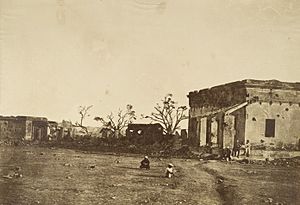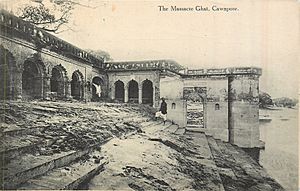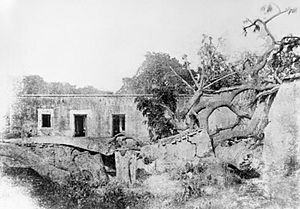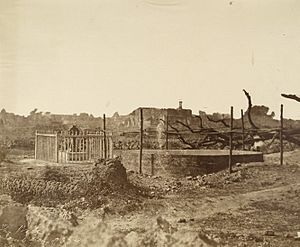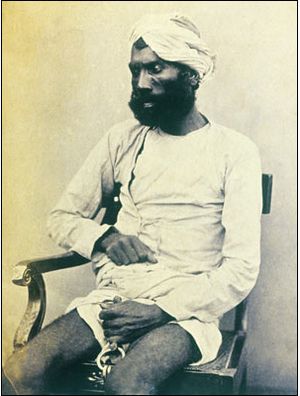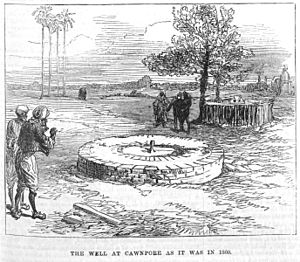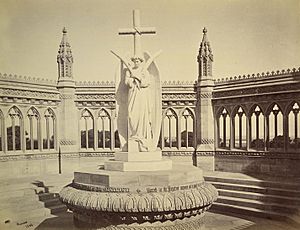Siege of Cawnpore facts for kids
Quick facts for kids Siege of Cawnpore |
|||||||
|---|---|---|---|---|---|---|---|
| Part of the Indian Rebellion of 1857 | |||||||
 A contemporary engraving of the massacre at the Satichura Ghat |
|||||||
|
|||||||
| Belligerents | |||||||
| Nana Sahib's forces Rebel Company soldiers |
|||||||
| Commanders and leaders | |||||||
| Major General Sir Hugh Wheeler † Brigadier Alexander Jack † Major Edward Vibart † Captain John Moore † |
Nana Sahib Azimullah Khan Tantya Tope Bala Rao |
||||||
| Strength | |||||||
| Around 900 including civilians and 300 soldiers | Around 4000 Rebels | ||||||
| Casualties and losses | |||||||
| All, except five men and two women | Unknown | ||||||
The siege of Cawnpore was a major event during the Indian rebellion of 1857. British forces and civilians in Cawnpore (now Kanpur) were surrounded by rebel soldiers led by Nana Sahib. They were not ready for a long fight. They surrendered, hoping to get safe passage to Allahabad. But their journey out of Cawnpore turned into a terrible event, and most of the men were killed.
Later, as British rescue forces got close to Cawnpore, about 120 British women and children were killed. This became known as the Bibighar Massacre. Their bodies were thrown into a nearby well to hide what happened. When British forces recaptured Cawnpore and found out about the massacre, they became very angry. They took revenge on captured rebel soldiers and local people. These killings made the British soldiers very determined, and "Remember Cawnpore!" became their battle cry.
Contents
Why the Siege Happened
Cawnpore was an important military town for the East India Company. It was located on a main road, connecting it to other key areas like Sindh, Punjab, and Awadh.
By June 1857, the rebellion had spread to many places near Cawnpore. However, the Indian soldiers (sepoys) in Cawnpore seemed loyal at first. The British General, Hugh Wheeler, knew the local language and had an Indian wife. He felt sure his sepoys would stay loyal. He even sent some British soldiers to help at the siege of Lucknow.
About 900 British people were in Cawnpore. This included 300 soldiers, 300 women and children, and 150 merchants and engineers. Many local servants left when the siege began.
General Wheeler chose a defensive spot in the south of the city. It was an area with two barracks surrounded by a mud wall. This was not a good choice. It was hot, hard to dig deep trenches, and had poor sanitation. There was only one well, which would be exposed to enemy fire. Also, other buildings nearby gave attackers good places to shoot from.
People still wonder why General Wheeler chose this spot. There were safer places in Cawnpore, like the city's main magazine. He might have expected help to arrive from the south. He also thought the Indian troops would just take their weapons and money and leave for Delhi. He didn't expect a long siege.
Rebellion Starts in Cawnpore
There were four Indian regiments in Cawnpore. Even though the sepoys hadn't rebelled yet, European families started moving into the defensive area. The British fortified the area and asked Indian sepoys to collect their pay one by one. This was to prevent a large, armed crowd.
The Indian soldiers saw the fortifications and prepared artillery as a threat. There were also rumors that they would be massacred at a parade. These things made them decide to rebel against the East India Company.
The rebellion began at 1:30 AM on June 5, 1857. Rebel soldiers fired three pistol shots. An older Indian officer, Bhowani Singh, who stayed loyal, was killed by his own men. The 53rd and 56th Native Infantry, thought to be loyal, were woken by the shots. Some soldiers tried to leave. European artillery fired on them, thinking they were rebelling. Soldiers of the 53rd were also caught in the crossfire.
The 1st Native Infantry rebelled and left on June 6. The 53rd Native Infantry also left, taking money and ammunition. About 150 sepoys remained loyal to General Wheeler.
After getting weapons and money, the rebel troops started marching towards Delhi. They wanted orders from Bahadur Shah II, who had been named "Emperor of India." The British officers were relieved, thinking the siege would be short.
Nana Sahib Joins the Rebels
Nana Sahib was the adopted son of Baji Rao II, a former leader of the Maratha people. The East India Company decided Nana Sahib would not get his father's pension or titles because he was not a birth heir. Nana Sahib sent his helper, Azimullah Khan, to London to ask the Queen to change this, but it didn't work.
In May 1857, Nana Sahib came to Cawnpore with 300 soldiers. He said he wanted to help the British. General Wheeler asked him to guard the government treasury.
During the chaos in Cawnpore, Nana Sahib entered the British magazine with his men. The soldiers guarding it thought he was there to help the British, as he had said he was loyal. But Nana Sahib joined the rebels instead.
After taking the treasury, Nana Sahib moved along the main road. He wanted to bring back the Maratha rule. He decided to try and capture Cawnpore. He met rebel soldiers at Kalyanpur who were on their way to Delhi. Nana Sahib first thought about fighting for the Mughal emperor. But Azimullah Khan told him that leading the rebels in Cawnpore would make him more famous than serving a weak king.
Nana Sahib asked the rebel soldiers to return to Cawnpore and help him defeat the British. They were unsure at first. But they agreed when he promised to double their pay and give them gold if they destroyed the British defenses.
Attack on the British Fort
On June 5, 1857, Nana Sahib sent a polite note to General Wheeler. He said he would attack the next morning at 10 AM. On June 6, Nana Sahib's forces attacked the British fort at 10:30 AM. The British were not fully ready, but they defended themselves for a long time. The attackers were afraid to enter the fort. They had been told that the fort had trenches filled with gunpowder that would explode if they got too close.
As news of Nana Sahib's attacks spread, more rebel sepoys joined him. By June 10, he was believed to be leading about 12,000 to 15,000 Indian soldiers.
The British held out in their temporary fort for three weeks. They had very little water and food. Many died from sunstroke and thirst. The ground was too hard to dig graves. So, the British piled dead bodies outside buildings. At night, they dragged them into a dry well. Poor sanitation led to diseases like dysentery and cholera, making the defenders even weaker. There was also a small outbreak of smallpox.
In the first week, Nana Sahib's forces surrounded the fort. They made holes in walls to shoot from and set up firing spots in nearby buildings. Captain John Moore fought back by sending small groups out at night. Nana Sahib moved his main base further away. In response to Moore's attacks, Nana Sahib tried a direct assault. But his soldiers were not eager to attack.
On June 11, Nana Sahib's forces changed their plan. They started firing heavily at specific buildings. They shot many round shots into the fort. They damaged some smaller barracks and tried to set buildings on fire.
The first big attack by Nana Sahib's side happened on the evening of June 12. But the attacking soldiers still believed in the gunpowder trenches. They did not enter the area. On June 13, the British lost their hospital building to a fire. This destroyed most of their medical supplies. Many wounded and sick soldiers burned to death. Losing the hospital was a huge blow. Nana Sahib's forces gathered for another attack. But they were pushed back by canister shot from the British artillery. By June 21, the British had lost about a third of their people.
General Wheeler sent many messages to Henry Lawrence, the officer in charge in Lucknow. But Lawrence couldn't help because his own fort was under siege.
Big Attack on June 23
Sniper fire and bombardment continued until June 23, 1857. This was exactly 100 years after the Battle of Plassey. That battle was very important in the growth of British rule in India. Many sepoys believed a prophecy that British rule would end exactly 100 years after Plassey. This led Nana Sahib's soldiers to launch a huge attack on the British fort on June 23.
The rebel soldiers of the 2nd Bengal Cavalry charged first. But they were pushed back by canister shot when they got within 50 yards of the British fort. After the cavalry, soldiers of the 1st Native Infantry attacked. They moved forward behind cotton bales and low walls. They lost their leader, Radhay Singh, to the first shots from the British. They hoped the cotton bales would protect them. But the bales caught fire from the canister shot, becoming dangerous. On another side of the fort, some rebel soldiers fought hand-to-hand against 17 British men. By the end of the day, the attackers could not get inside the fort. The attack left over 25 rebel soldiers dead, with very few British casualties.
British Surrender
The British fort had suffered many losses from constant attacks, sniper fire, and assaults. They were also suffering from disease and low supplies of food, water, and medicine. General Wheeler was very sad after his son was killed by a cannonball. With Wheeler's permission, a man named Jonah Shepherd secretly left the fort to check on Nana Sahib's forces. He was quickly captured by the rebels.
At the same time, Nana Sahib's forces were afraid to enter the fort. They still believed it had gunpowder-filled trenches. Nana Sahib and his advisors came up with a plan to end the stalemate. On June 24, they sent a European prisoner, Mrs. Rose Greenway, to the fort with their message. Nana Sahib promised safe passage for the British to the Satichaura Ghat. This was a landing spot on the Ganges River, where they could leave for Allahabad. General Wheeler refused the offer. It wasn't signed, so he wasn't sure it was from Nana Sahib himself.
The next day, June 25, Nana Sahib sent a second note, signed by him. It came through another elderly female prisoner, Mrs. Jacobi. The British camp was divided. Some wanted to keep fighting, while others were willing to trust Nana Sahib. For the next 24 hours, Nana Sahib's forces did not attack. Finally, General Wheeler decided to surrender. He agreed to safe passage to Allahabad. After a day of getting ready and burying their dead, the British decided to leave on the morning of June 27, 1857.
Satichaura Ghat Massacre
On the morning of June 27, a large British group led by General Wheeler left their fort. Nana Sahib sent carts, dolis (covered chairs), and elephants. These were for the women, children, and sick to get to the river. British officers and soldiers were allowed to take their weapons. They were escorted by almost the entire rebel army. The British reached the Satichaura Ghat by 8 AM. Nana Sahib had arranged about forty boats for their trip to Allahabad.
The Ganges River was very low at Satichaura Ghat. The British found it hard to move the boats. General Wheeler's boat was the first to get moving. There was some confusion. Indian boatmen jumped overboard after hearing bugles from the riverbanks. They swam to shore. As they jumped, some fires on the boats were knocked over, setting a few boats on fire.
What happened next at Satichaura Ghat is still debated. No one knows for sure who fired the first shot. But soon after, the British leaving were attacked by rebel sepoys. They were either killed or captured.
Some British officers later said the rebels had purposely placed the boats in the mud to cause delays. They also claimed Nana Sahib's camp had planned for the rebels to fire on and kill all the British. The East India Company later accused Nana Sahib of betrayal and murder. However, no proof has ever been found that Nana Sahib planned or ordered the massacre. Some historians believe the Satichaura Ghat massacre happened because of confusion, not a plan. Lieutenant Mowbray Thomson, one of the few male survivors, thought the sepoys he spoke to didn't know about the coming killings.
After the fighting started, Nana Sahib's general, Tatya Tope, supposedly ordered the 2nd Bengal Cavalry and some artillery to fire on the British. Rebel cavalry soldiers went into the water to kill the remaining British soldiers with swords and pistols. The surviving men were killed. The women and children were taken prisoner. Nana Sahib did not approve of killing them. About 120 women and children were taken to Savada House, Nana Sahib's headquarters.
By this time, two boats had managed to get away. One was General Wheeler's boat. The other had a hole from a cannonball. The British on the second boat panicked and tried to reach General Wheeler's boat, which was slowly moving to safer waters.
General Wheeler's boat had about sixty people. Rebel soldiers chased it along the riverbanks. The boat often got stuck on sandbanks. On one sandbank, Lieutenant Thomson led a charge against the rebels. He managed to get some ammunition. The next morning, the boat got stuck again. Thomson and eleven British soldiers charged again. After a fierce fight, Thomson and his men decided to return to the boat. But they couldn't find it where they expected.
Meanwhile, rebels attacked the boat from the opposite bank. After some firing, the British men on the boat decided to raise a white flag. They were taken off the boat and brought back to Savada House. The surviving British men were made to sit on the ground. Nana Sahib's soldiers got ready to fire. Their wives insisted they would die with their husbands, but they were pulled away. Nana Sahib allowed the British chaplain to read prayers before they died. The British men were first wounded by guns, then killed with swords. The women and children were kept at Savada House. They were later moved to Bibighar with other captured British people.
Unable to find the boat, Thomson's group decided to run barefoot to escape the rebels. They hid in a small shrine. Thomson led a final charge. Six British soldiers were killed. The rest escaped to the riverbank. They tried to swim to safety. But a group of rebels from the village started hitting them as they reached the bank. One soldier was killed. The other four, including Thomson, swam back to the middle of the river. After swimming for a few hours, they reached shore. Some Rajput soldiers, loyal to a British supporter, found them. These soldiers took the British men to the Raja's palace. These four British soldiers were the only male survivors from the British side, besides Jonah Shepherd (who was captured earlier). The four men were Privates Murphey and Sullivan, Lieutenant Delafosse, and Lieutenant (later Captain) Mowbray Thomson. They spent weeks recovering. They eventually returned to Cawnpore, which was back under British control. Murphey and Sullivan died soon after from cholera. Delafosse joined the defense of Lucknow. Thomson helped rebuild and defend the fort a second time. He later wrote a book about his experiences.
Another survivor of the Satichaura Ghat massacre was Amy Horne, a 17-year-old Anglo-Indian girl. She fell from her boat and was swept downstream. She met Wheeler's youngest daughter, Margaret. The two girls hid for hours. Rebels found them. Margaret was taken away and never seen again. Amy was taken to a nearby village. A Muslim rebel leader protected her in exchange for her converting to Islam. Six months later, Highlanders rescued her.
Bibighar Massacre
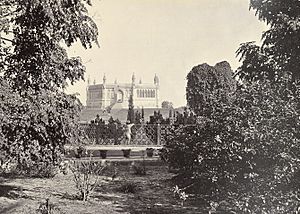
The surviving British women and children were moved from Savada House to Bibighar. This was a house in Cawnpore known as "The House of the Ladies." About 120 women and children were first held there. They were later joined by survivors from General Wheeler's boat. Other European women and children captured from Fatehgarh were also brought to Bibighar. In total, there were around 200 women and children.
The captives were made to grind corn for bread. Poor sanitation at Bibighar led to deaths from cholera and dysentery.
Nana Sahib wanted to use these prisoners to bargain with the East India Company. British forces, led by General Henry Havelock, had left Allahabad to retake Cawnpore and Lucknow. Havelock's forces included about 1,000 British soldiers, 150 Sikh soldiers, and 30 cavalry. They were later joined by forces under Colonel James George Smith Neill. Nana Sahib demanded that the British forces retreat to Allahabad. But the British kept advancing towards Cawnpore. Nana Sahib sent an army to stop them. The two armies met at Fatehpur on July 12. General Havelock's forces won and captured the town.
Nana Sahib then sent another force led by his brother, Bala Rao. On July 15, General Havelock's forces defeated Bala Rao's army in the Battle of Aong. On July 16, Havelock's forces started moving towards Cawnpore. During the Battle of Aong, Havelock captured some rebel soldiers. They told him there was a larger rebel army with 5,000 soldiers and 8 cannons further ahead. Havelock tried a surprise attack from the side. But the rebels saw it and opened fire. The battle caused many deaths on both sides. But it cleared the way to Cawnpore for the British.
By this time, it was clear that Nana Sahib's bargaining had failed. The British forces were getting close to Cawnpore. Nana Sahib heard that British troops were being violent against Indian villagers. Some believe the Bibighar massacre happened as a reaction to this news. Others suggest it was to prevent key rebel leaders from being identified if the prisoners were freed.
Nana Sahib and his advisors, including Tatya Tope and Azimullah Khan, discussed what to do with the captives at Bibighar. Some advisors had already decided to kill the captives as revenge for British actions. The women of Nana Sahib's family opposed this. They even went on a hunger strike, but it didn't change the decision.
Finally, on July 15, an order was given to kill the women and children at Bibighar. The exact details, like who gave the order, are not clear.
The rebel sepoys killed the four male prisoners from Fatehghar, including a 14-year-old boy. But they refused to kill the women and other children. Some sepoys agreed to remove the women and children from the courtyard. Tatya Tope threatened to execute them if they didn't. Nana Sahib left the building because he didn't want to see what was happening.
The British women and children were told to come out. But they refused and held onto each other. They blocked the doors by tying handles with clothing. At first, about twenty rebel soldiers fired from outside Bibighar, shooting through holes in the windows. The soldiers who were supposed to fire next were disturbed by the scene. They shot their guns into the air. Soon after, hearing the screams inside, the rebel soldiers threw down their weapons. They said they would not kill any more women and children.
An angry Begum Hussaini Khanum called the sepoys cowards. She asked her helper to finish the job. Her lover hired butchers. They murdered the captives with cleavers. The butchers left when they thought everyone was dead. However, a few women and children survived by hiding under the other bodies. It was decided that sweepers would throw the bodies into a dry well. The next morning, when the rebels came to dispose of the bodies, they found three women and three children (aged four to seven) still alive. The surviving women were thrown into the well by the sweepers. The sweepers also threw the three little boys into the well, one at a time, youngest first. Some victims, including small children, were buried alive under a pile of dead bodies. None survived.
British Recapture and Revenge
The British forces reached Cawnpore on July 16 and captured the city. A group of British officers and soldiers went to Bibighar. They hoped to rescue the captives, thinking they were still alive. But when they arrived, they found the place empty and covered in blood. The bodies of most of the 200 women and children had already been cut up and thrown into the courtyard well or the Ganges River. Piles of children's clothes and cut women's hair were blowing in the wind. The tree nearest the well was smeared with the brains of many children and babies who had been smashed against its trunk and thrown into the well.
The British troops were horrified and furious. When they learned about the massacre, the angry British soldiers attacked the local people of Cawnpore. They looted and burned houses. They said it was because no local people had tried to stop the massacre. Brigadier General Neill took command in Cawnpore. He immediately started quick and harsh military trials for any rebel sepoy captured in the city. If a sepoy couldn't prove they weren't involved in the massacre, they were quickly executed. Rebels who confessed or were believed to be involved were forced to lick the blood-stained floor of the Bibighar. This was done after it was wet with water by low-caste people, while they were whipped. The sepoys were then religiously shamed. Hindus were forced to eat beef, and Muslims were forced to eat pork. Muslim sepoys were sewn into pig skins before being hanged. Low-caste sweepers were used to execute high-caste Brahmin rebels. This added more religious shame to their punishment. Some were also forced to clean buildings stained with blood before being publicly hanged.
Most prisoners were hanged where the Bibighar well could be seen. They were buried in shallow ditches by the road. Others were shot or stabbed with bayonets. Some were tied across cannons that were then fired. This was an execution method used by the rebels and earlier Indian rulers. It's not clear if this method was only for special prisoners or done out of anger.
The massacre disgusted and angered British troops in India. "Remember Cawnpore!" became a battle cry for British soldiers for the rest of the conflict. Acts of quick violence against towns and cities believed to support the rebellion also increased. In one village, British soldiers caught about 140 men, women, and children. Ten men were hanged without any proof or trial. Sixty other men were forced to build the gallows. Others were whipped and beaten. In another village, about 2,000 villagers protested with sticks. The British soldiers surrounded them and set the village on fire. Villagers trying to escape were immediately killed.
What Happened Next
On July 19, General Havelock continued his operations at Bithoor. Major Stevenson led British and Sikh soldiers to Bithoor. They took over Nana Sahib's palace without any fighting. The British troops took guns, elephants, and camels. They then set Nana Sahib's palace on fire.
In November 1857, Tatya Tope gathered an army, mostly rebel soldiers from Gwalior. He wanted to recapture Cawnpore. By November 19, his 6,000-strong force controlled all routes west and north-west of Cawnpore. However, his forces were defeated by British troops under Colin Campbell in the Second Battle of Cawnpore. This marked the end of the rebellion in the Cawnpore area. Tatya Tope then joined Rani Lakshmibai.
Nana Sahib disappeared. By 1859, he was reportedly in Nepal. What finally happened to him was never known. Until 1888, there were rumors that he had been captured. Several people claimed to be the aged Nana. Most of these reports were false, so further attempts to catch him were stopped.
British civil servant Jonah Shepherd, who was rescued by Havelock's army, spent years trying to list those killed in the fort. He had lost his entire family during the siege. He eventually retired to a small estate north of Cawnpore in the late 1860s.
Memorials
After the rebellion was put down, the British tore down Bibighar. They built a memorial fence and cross at the well where the bodies of the British women and children had been thrown. The British also destroyed Nana Sahib's palace in Bithoor with cannons. The people of Cawnpore were forced to pay £30,000 for the memorial. This was a 'punishment' for not helping the British women and children in Bibighar.
The Angel of the Resurrection statue was created by Baron Carlo Marochetti and finished in 1865. It became the most visited statue in British India. Charlotte, Countess Canning, wife of the first Viceroy of India, funded it. She asked her childhood friend, Marochetti, for designs. Marochetti suggested other sculptors be invited. After the Countess died, her husband, Earl Canning, took over the project. Canning rejected many designs. He finally accepted a version of Marochetti's Crimean War memorial. The angel holds two palm branches across her chest. Despite promises, 'The Angel' was damaged during India's Independence celebrations in 1947. It was later moved from its original spot over the Bibighar well to a garden next to All Souls Church in Kanpur.
The remains of a circular ridge of the well can still be seen at the Nana Rao Park, built after India became independent. The British also built the All Souls Memorial Church to remember the victims. A paved area outside the church marks the graves of over 70 British men captured and executed on July 1, 1857. A marble screen with an angel was moved to the churchyard after India's independence in 1947. There were plans to replace the British memorial with a statue of Tatya Tope. But the local British community strongly objected. The statue was eventually placed some distance away.
There is a plaque for Captain W. Morphy and Lieutenant Thomas Mackinnon in Lichfield Cathedral. They were killed on November 28, 1857.
Another memorial, detailing losses of the 32nd Cornwall Regiment Light Infantry, is inside the west entrance to Exeter Cathedral.
More to Explore
- Second Battle of Cawnpore
- Indian rebellion of 1857
- Jallianwala Bagh massacre
- Patharighat massacre
- List of massacres in India


